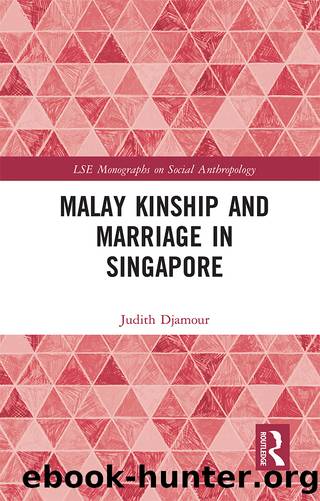Malay Kinship and Marriage in Singapore by Judith Djamour

Author:Judith Djamour [Djamour, Judith]
Language: eng
Format: epub
Google: cXALAAAAIAAJ
Publisher: University of London, Athlone Press
Published: 1959-01-15T03:53:43+00:00
Marriage of Janda
So far we have considered the marriage of an anak dara with a bujang sÄkali. Other possible unions are between an anak dara and a man who has been previously married; between ajanda and a bujang sÄkali; and between a janda and a man previously married.
In the first case, that of a union between an anak dara and a man who has been previously married, the same care was generally taken about the marriage arrangements as obtained when it was a first marriage for both parties, and ceremonies were usually on as elaborate a scale. When a wedding was discussed, the marital status of the bride, not that of the groom, was the chief consideration. The distinction was primarily between an anak dara wedding and a janda wedding, the former being recognized as an occasion for more pomp and rejoicing than the latter. A widower or divorced man could and did sit in state, bersanding, when he married an anak dara (although this bÄrsanding was not considered as of quite the same order as that of a couple being married both for the first time).
It was deemed suitable for janda to marry men who were either widowed or divorced. If a bujang sÄkali were to marry a janda he would forgo the valued privilege of sitting in state with his bride on the occasion of his first wedding. Sometimes, however, if the janda was very young (in her late teens or early twenties) and had no children, a bÄrsanding on a somewhat modest scale was arranged. It would be difficult to over-estimate the importance which both men and women attached to this ceremonial. The few minutes during which the couple sat enthroned were their greatest glory: again and again Malays stressed that the couple were like a king and queen (macham raja) during those minutes.
Preferential forms of marriage for a janda were the same as for an anak dara, except that less careful attention was given to the planning of the second marriage by her legal guardian. For instance, there was less resistance shown by her relatives if a local Malay janda married an immigrant Malay than there would have been if the bride were still an anak dara. Also, a janda frequently married a man who was her senior by ten or more years, whereas the discrepancy between the ages of an anak dara bride and her groom was rarely as great.
As far as consent was concerned, in accordance with Muslim law and Malay custom a janda was consulted regarding any proposed match, and if she was unwilling the union rarely took place: her first marriage had emancipated her. However, there were sometimes very young janda for whom their guardians arranged a second marriage without consultation.
Whereas the wedding ceremonies of an anak dara usually continued over a period of two or three days, those of a janda lasted only one morning or afternoon. After the nikah a small meal was served to the few guests present. As
Download
This site does not store any files on its server. We only index and link to content provided by other sites. Please contact the content providers to delete copyright contents if any and email us, we'll remove relevant links or contents immediately.
Nudge - Improving Decisions about Health, Wealth, and Happiness by Thaler Sunstein(7261)
iGen by Jean M. Twenge(5167)
The Fire Next Time by James Baldwin(5025)
Adulting by Kelly Williams Brown(4242)
The Hacking of the American Mind by Robert H. Lustig(4094)
The Sports Rules Book by Human Kinetics(4081)
The Ethical Slut by Janet W. Hardy(4042)
Captivate by Vanessa Van Edwards(3733)
Mummy Knew by Lisa James(3523)
In a Sunburned Country by Bill Bryson(3376)
The Worm at the Core by Sheldon Solomon(3328)
Ants Among Elephants by Sujatha Gidla(3282)
Suicide: A Study in Sociology by Emile Durkheim(2908)
The Slow Fix: Solve Problems, Work Smarter, and Live Better In a World Addicted to Speed by Carl Honore(2844)
The 48 laws of power by Robert Greene & Joost Elffers(2818)
Humans of New York by Brandon Stanton(2694)
Handbook of Forensic Sociology and Psychology by Stephen J. Morewitz & Mark L. Goldstein(2606)
The Happy Hooker by Xaviera Hollander(2586)
The Tipping Point by Malcolm Gladwell(2565)
